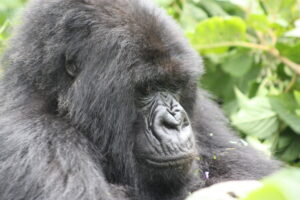
Mountain gorillas in Uganda “The Pearl of Africa”
Mountain gorillas in Uganda “The Pearl of Africa”
Mountain gorillas (gorilla beringei beringei) are the biggest type of great apes. Mountain Gorillas are a subspecies of the Eastern Gorilla (Gorilla Beringei), the other half of the group are the lowland Gorillas. Mountain Gorillas live in high places between 8,000 and 15,000 feet in thick woods, rainforests, bamboo forests, mixed forests, and grassy areas on volcano tops. They are not bound to one area, so they move around in their home to find more food and safer spots. They always stay together as they move. Mountain gorillas cannot live in captivity because their natural environments are crucial for their survival.
Gorillas are smart and can use different tools for various tasks. They are usually gentle and peaceful, but they can become upset if they are startled or provoked. They are plant-eating animals that eat trees, shoots, and stems. They can also eat bark, roots, flowers, and small insects. Males can eat up to 34 kilograms, while females can eat up to 18 kilograms.
Mountain gorillas live in tight-knit groups of about 5 to 30 members, led by a strong adult male called a silverback. The silverback is the leader of the group. It chooses where the group will stay and eat, and it helps keep peace by resolving any arguments that come up. The silverback gorilla protects his family by fighting off any attackers, even risking his life. Some silverbacks have also learned how to help group members by removing traps from their hands and feet. The silverback, as the king, always eats first.
Typically, each family has one male, called a silverback, along with several females and their babies. But it’s common to see groups that have more than one guy. When a female gorilla dies, the silverback male will care for her young until they grow up. If the silverback dies, the group may split up or find another strong male. If there is a suitable male offspring in the group, he will become the new leader. If not, another silverback may take over and will likely kill all the young gorillas.
Each Gorilla group usually has two adult females that stay with the silverback for life. A female Gorilla gives birth every four years and is pregnant for about 8.5 months. Baby gorillas usually weigh between 1.4 and 1.8 kg at birth. They grow twice as fast as humans, so they gain weight quickly. The mother breastfeeds her baby for 3 to 4 years, and during that time, the baby stays with her. This helps lower the number of baby gorilla deaths caused by illnesses and accidents.
Young male gorillas become mature at 10 years old, which is when their black backs start to turn grey. They leave their mother’s group at 11 years old and may live alone or with other single male gorillas for 2 to 5 years until they find females to start their own group. Female animals grow up and become mature by age 6. By age 8, they usually leave their mother’s group to join another group or pair up with a single male to create a new group.
 When two groups meet, the silverbacks are likely to fight. The bigger silverback usually takes control of the other group.
When two groups meet, the silverbacks are likely to fight. The bigger silverback usually takes control of the other group.
Gorillas enjoy playing together, especially the baby gorillas. They also take a break at midday, which is important for them to rest and refresh.
These animals are usually calm, but they can become aggressive if they feel threatened. They may charge at you and use their sharp teeth to inflict serious injuries, which could be deadly. If a gorilla comes at you, it’s best to stay where you are. It will often back off after a short while.
Gorillas dislike rain and water. They will only walk over water if there’s a dry log they can use to stay dry. They are also scared of chameleons and bugs.
Gorillas and humans are quite similar. When they come into contact, there’s a good chance that diseases may be passed from people to gorillas.
Mountain Gorillas are mostly hunted by people and leopards. people poach them, while leopards kill and eat them.
12 Days in Rwanda Uganda Primates Tour Gorillas Mountain Gorillas have been considered critically endangered since 1996, according to the IUCN Red List. Their numbers are decreasing because of habitat loss caused by humans, poaching, and their slow reproduction. Additionally, nearly 30% of baby gorillas don’t survive their first year due to diseases and accidents.
Since the 1990s, global funding has supported programs to protect mountain gorillas in their two main homes: Bwindi Impenetrable National Park in Uganda and the Virunga Mountains in Rwanda and the Democratic Republic of Congo. By 2018, the number of mountain gorillas had increased to 1,004. Conservation efforts are ongoing today, including projects to protect Mountain Gorilla habitats and improve laws to stop gorilla poaching.
You can support mountain gorilla protection or visit them in their natural homes in Uganda, Rwanda, and the Democratic Republic of Congo.Bwindi Impenetrable National Park Uganda, Mgahinga National Park Uganda, Virunga National park DRC, Volcanoes National Park Rwanda


